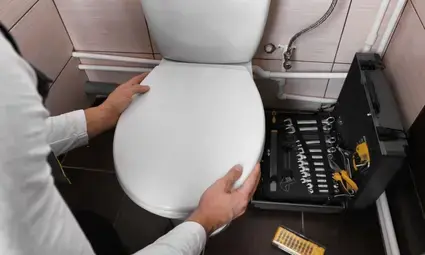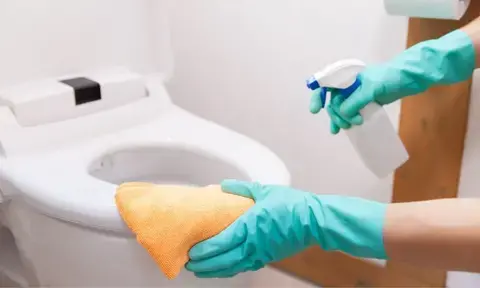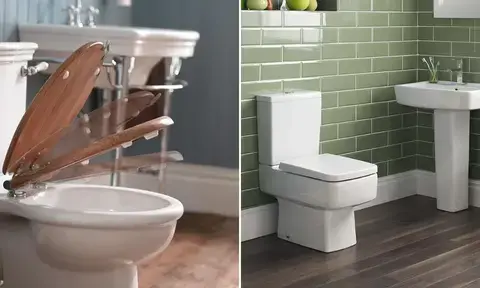
Whether you want to replace a damaged toilet seat or upgrade to a premium model, it’s important that you learn how to replace a toilet seat properly. An improperly fitted toilet seat not only feels uncomfortable but also looks awful.
Fortunately, replacing a toilet seat is a fairly simple, quick, and straightforward task. You only require elementary DIY skills. And with the right tools, you can complete this task in a few minutes.
The goal of this DIY blog post is to teach you how to replace a toilet seat without professional help.
- How to Measure a Toilet Seat?
- Tools You’ll Need to Replace a Toilet Seat
- Safety Measures to Follow Before Changing Toilet Seat
- How to Replace a Toilet Seat
- Why Should I Replace My Toilet Seat?
- Do All Toilet Seats Fit the Same?
Navigate to any section of this post by clicking on the links above.
How to Measure a Toilet Seat?
There’s no right time to replace a toilet seat, as it doesn’t have an expiry date.
That aside, taking the right measurements is the most important part before you buy a new toilet seat. You really want to ensure you buy one that perfectly fits your toilet bowl.
Both plastic and wooden toilet seats share some standard measurements. Toilet bowls also have some standard measurements. Round toilet bowls measure approximately 16.5in (42cm) in length, and elongated toilet bowls measure approximately 18.5in (47cm) in length.
The following are the steps to measure your toilet seat:
- Measure the toilet bowl length from the centre point of the seat bolts to the outer edge of the front of the bowl.
- Measure the distance between the bolts where the toilet seat is attached to the bowl.
- Measure the width of the toilet bowl at its widest point.
When it comes to taking measurements, it’s best to heed the old carpenter’s principle: “Measure twice, cut once.”
In your case, it is, “Measure twice, order once.” It’s better to avoid needless frustration by investing a few more seconds to confirm the right dimensions.
Tools You’ll Need to Replace a Toilet Seat
You’ll need minimal tools to replace a toilet seat. Keep the following tools handy as they can make the task easy:
- Replacement toilet seat.
- Tape measure.
- Flathead screwdriver.
- Pliers/adjustable wrench.
- Spray lubricant or soap solution.
- New sets of nuts and bolts.
Safety Measures to Follow Before Replacing Toilet Seat

Before you remove the old toilet seat, bear in mind that toilets are natural habitats for hazardous germs. Exposure to these microbes can lead to serious illness and infections.
Therefore, take the necessary precautions before you begin the task. The essential measures include the following:
- Wear rubber gloves.
- Clean the toilet with an anti-bacterial spray.
How to Replace a Toilet Seat
When buying a toilet seat, choose the right colour and material. Once you are convinced that the seat you have chosen fits the dimensions of your toilet bowl and matches your bathroom aesthetic, you can go ahead with your DIY project.
Follow the steps detailed below:
1. Remove the Old Toilet Seat
The environment inside a bathroom – the high humidity and lack of ventilation – can quickly corrode the metallic bolts that fasten the seat to the bowl.
The good news is, in some models, plastic bolts are used. Removing the old toilet seat, in this case, is much simpler. Therefore, the difficulty or simplicity of removing the old seat depends on whether it’s attached using plastic or metal bolts.
The first step is to take off the bolt caps located at the inner edge of the seat. This is where the seat’s hinges are fastened to the bowl.
Not all bolts have these caps. If your toilet has these bolts, pry them off carefully with the flathead screwdriver.
Next, loosen the two nuts on either side of the toilet using the adjustable wrench. You can do this by fixing the wrench on the nut and turning it counter-clockwise to loosen it.
Remove the bolts located at the bottom of the hinges (top surface of the toilet bowl). Turn each bolt counter-clockwise with your hands until they come off. In case there are washers, remove them too.
If there is rust build-up – this is quite normal – spray the bolts with a lubricant. (In case of stubborn plastic bolts, use soap solution.) Let it rest for a few minutes. Unscrew the bolts now.
After you remove the old toilet seat, simply dispose of it.
2. Clean the Toilet Bowl
After you remove the old toilet seat, clean the toilet bowl once more thoroughly, using an anti-bacterial spray. Focus on the area around the bolts, as it is inaccessible once the seat is fitted.
Wipe the surface dry with wipes. (Don’t flush the wipes down the toilet. Instead, put them in the bin.)
3. Fit the New Toilet Seat
Unpack the new toilet seat. Place it in the right position on the toilet bowl surface. Ensure that the new seat hinges align with the points of the old seat hinges. If the alignment is accurate, inserting the bolts will be easy.
Now, take the two bolts and insert them through the holes in the hinges. Make sure the bolt head is facing upwards when you insert the bolts, as this will prevent the bolts from slipping through the holes in the hinges.
Once the bolts are in the right position, place a nut on the bolt thread. Turn the nuts clockwise on the bolts to tighten them. The bolt ends will stick through the top of the toilet bowl. Use an adjustable wrench to tighten both the nuts.
In premium toilet seats, you don’t need to drive bolts through the hinges. They come with two self-lock nuts, making it easy to snap the seat in place.
Refer to the user manual if you purchase a new model of toilet seat. Ensure you follow the instructions outlined throughout the process and fit the new toilet seat correctly.
If the toilet seat bolts have plastic caps, snap them in position by gently pushing them down the bolt heads.
Congratulations!
Now that you have successfully replaced the toilet seat, wash your hands using an anti-microbial hand wash.
Why Should I Replace My Toilet Seat?
If your toilet seat has cracks or simply faded over the years, it’s time to replace it. Small cracks can be a breeding ground for mould, mildew, and harmful germs.
Even minor damage to the fixtures can render your toilet seat unusable. Also, a toilet seat past its prime will only spoil the aesthetic of your bathroom.
A new, beautiful-looking toilet seat is an excellent choice because it will complement the rest of your bathroom decor.
You can count on a durable toilet seat to remain in good condition for many years. And you can use it comfortably, as well.
Do All Toilet Seats Fit the Same?

The short answer is no. Toilet seats are not universal.
Since toilets come in different shapes, all toilet seats don’t fit the same. Toilet bowls come in the following three shapes:
- Round
- Elongated
- Rectangular
Despite the different shapes, all toilet seats share one common feature. The distance between the two bolts that fasten the seat to the toilet bowl is universal, regardless of the shape of the bowl. This distance is approximately 5.5in (14cm) between the centres of the toilet seat post holes.
As a result, while you can fit any toilet seat on any bowl, it won't fit perfectly. Also, it will not look right. The key disadvantage is that sitting on the wrong type of toilet seat can be quite uncomfortable.
Shop Toilet Seats
At Bathroom City, you’ll find an assortment of toilet seats – round, elongated, and D-shape – in a range of colours and sizes. Regardless of the measurements of your toilet bowl, we are certain that you’ll find the perfect shape and fit that fulfils your needs. You can also choose from different materials – solid wood, Carbamide, and wood (MDF).
Additional articles you may enjoy reading: